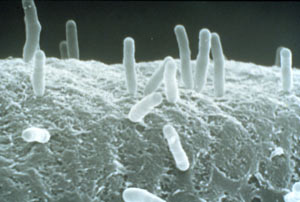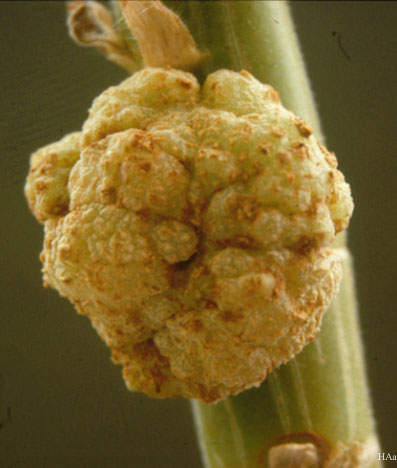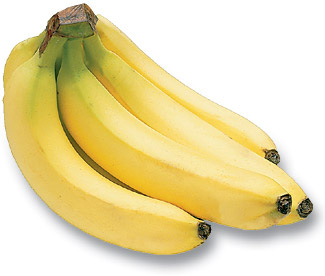|
Agrobacterium tumefaciens is a Gram-negative, non-sporeforming, rod-shaped bacterium. Agrobacterium strains use different carbohydrates and are classified into three main biovars. The differences among biovars are mainly determined by the genes on the circular chromosome. A. tumefaciens is known for calling the formation of galls on plants that it infects. When a wound opens on the plant tissue, the motile cells of A. tumefaciens move into the tissue by chemotaxis as a response to the release of sugars and other components normally in the roots. While A. tumefaciens cells without Ti plasmids recognize and move towards plant wounds, the strains containing the Ti plasmids respond even more strongly because they recognize phenolic compounds such as acetosyringone that come out of the wound (Deacon).
Ecology
Agrobacterium tumefaciens can generally be found on and around root surfaces known as the rhizosphere. There it seems to use nutrients that leak from the root tissue. It will infect the tissue at wound sites formed from transplanting seedlings, burrowing animals or bugs, etc (Deacon). Agrobacterium radiobacter grows on various explosives such as nitroglycerine - they use this as their sole source of nitrogen. It removes two nitro groups from nitroglycerine by an NADH-dependent oxidoreductase, but can not use the carbon in nitroglycerine for growth because it cannot remove the third nitro group to release glycerol (White).
Crown Gall Disease
Agrobacterium tumefaciens is most widely known for causing crown gall disease that affects many dicotyledonous (broad-leaved) plants; another strain called biovar 3 causes crown gall disease in grapvines. The disease causes the formation of tumor-like swellings called galls that can generally be found on the crown of the plant just above the soil. Crown gall disease does not usually seriously harm older plants; however, it may reduce the value of a plant in a nursery.
Agrobacterium tumefaciens causes crown gall disease by first transferring part of its DNA into an opening in the plant. The DNA is attches itself to the plants DNA through histones. The DNA then integrates itself into the plant's genome and causes the formation of the gall. Because of how smoothly Agrobacterium tumefaciens is able to transfer DNA it has become a helpful tool for scientists to use.
Banana Vaccines
Bananas have potential to become the world's first edible vaccine due to Agrobacterium. An edible vaccine doesn't need sterile syringes, costly refrigeration, or multiple injections. According to the World Health Organization (WHO), more than 2 million children die worldwide each year from diarrhea that can be prevented easily with vaccines.
Thus, researchers lead by Dr. Charles Arntzen are looking into making the food vaccines to prevent diarrhea caused by Escherichia coli and Vibrio cholara bacteria. First, the gene for an immune system-stimulating disease protein would have to be spliced into the bacterium. The bacterium is then allowed to contaminate banana cells, inserting the Ti plasmid (containing the spliced gene) into their chromosomes. The next step is to grow the cells until they are mature fruit-bearing plants. The fruits, when eaten, would transfer the immunity to a particular disease into the consumer's body. This would be a relatively inexpensive and feasible method to distribute certain vaccines to people, especially in developing countries.
This has already been shown to work using potatoes and a modified E. coli protein that is known to cause severe diarrhea. When mice ate the raw engineered potatoes, they developed the antibodies to the E. coli toxin. Clinical tests on humans eating genetically engineered potatoes also showed that they started producing antibodies against Norwalk virus, which causes acute bouts of diarrhea (Redig 2003). For now, all clinical trials involve genetically modified potatoes or tomatoes, both of which can easily be freeze-dried, transported, and reconstituted. These can be more easily dosage regulated and quality controlled, unlike a banana tree growing in the middle of a village, for example. But the ideal of fresh banana vaccines is still being developed and perfected.
References
Brown, Kathryn. 1996. "Vaccine Cuisine." Environmental Health Perspectives, vol. 104, no. 3.
Deacon, Jim. The University of Edinburgh: The Microbial World: Biology and Control of Crown Gall (Agrobacterium tumfaciens).
Abraham Loyter, Joseph Rosenbluh, Nehama Zakai, Jianxiong Li, Stanislav V. Kozlovsky, Tzvi Tzfira and Vitaly Citovsky. The Plant VirE2 Interacting Protein 1. A Molecular Link between the Agrobacterium T-Complex and the Host Cell Chromatin?Plant Physiology, July 2005, Vol. 138, pp. 1318-1321.
Redig, Mandy. 2003. "Banana vaccines: A conversation with Dr. Charles Arntzen." Journal of Young Investigators, vol. 7, no. 1.
White, Graham. The Molecular Cell Biology Research Group: Research
|



